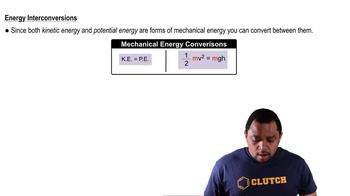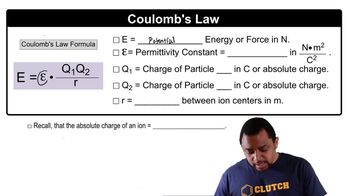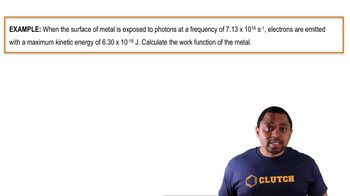(a) Calculate the kinetic energy (in joules) of a 1200-kg automobile moving at 18 m/s.
Ch.1 - Introduction: Matter, Energy, and Measurement
Chapter 1, Problem 31b
Two positively charged particles are first brought close together and then released. Once released, the repulsion between particles causes them to move away from each other. b. Does the electrostatic potential energy of the two particles increase or decrease as the distance between them is increased?
 Verified step by step guidance
Verified step by step guidance1
Identify the type of force between the two positively charged particles. Since both particles are positively charged, they repel each other due to electrostatic force.
Understand the relationship between electrostatic potential energy and distance in the context of repulsive forces. The electrostatic potential energy (U) between two charges is given by the formula U = k \frac{q_1 q_2}{r}, where k is Coulomb's constant, q_1 and q_2 are the magnitudes of the charges, and r is the distance between the charges.
Analyze how the potential energy changes with distance. In the formula, as the distance r increases, the denominator of the fraction increases, causing the overall value of U to decrease.
Conclude the effect on electrostatic potential energy as the distance increases. Since the potential energy decreases as the distance between the two positively charged particles increases, the electrostatic potential energy decreases.
Apply the conservation of energy principle. The decrease in electrostatic potential energy implies that the system's kinetic energy must increase to conserve the total energy, explaining why the particles accelerate away from each other.

Verified video answer for a similar problem:
This video solution was recommended by our tutors as helpful for the problem above.
Video duration:
3mWas this helpful?
Key Concepts
Here are the essential concepts you must grasp in order to answer the question correctly.
Electrostatic Potential Energy
Electrostatic potential energy is the energy stored in a system of charged particles due to their positions relative to each other. It is defined as the work done to assemble the charges from infinity to their current positions. For two like charges, this energy is positive and decreases as the distance between them increases, indicating that the system becomes more stable.
Recommended video:
Guided course

Kinetic & Potential Energy
Coulomb's Law
Coulomb's Law describes the force between two charged particles, stating that the force is directly proportional to the product of the magnitudes of the charges and inversely proportional to the square of the distance between them. This law explains that like charges repel each other, leading to an increase in distance and a corresponding change in potential energy as they move apart.
Recommended video:
Guided course

Coulomb's Law Concept 2
Work and Energy Relationship
The relationship between work and energy is fundamental in physics, where work done on a system results in a change in energy. In the context of electrostatics, as two positively charged particles are separated, work is done against the electrostatic force, leading to an increase in potential energy. Thus, as the distance increases, the potential energy of the system also increases.
Recommended video:
Guided course

Work Function Calculation Example
Related Practice
Textbook Question
1
views
Textbook Question
Two positively charged particles are first brought close together and then released. Once released, the repulsion between particles causes them to move away from each other. a. This is an example of potential energy being converted into what form of energy?
Textbook Question
For each of the following processes, does the potential energy of the object(s) increase or decrease? (b) Water is pumped from ground level to the reservoir of a water tower 30 m above the ground.
Textbook Question
Use appropriate metric prefixes to write the following measurements without use of exponents: c. 6.48×10-7 L
Textbook Question
Use appropriate metric prefixes to write the following measurements without use of exponents: d. 1.81×10-2 s
